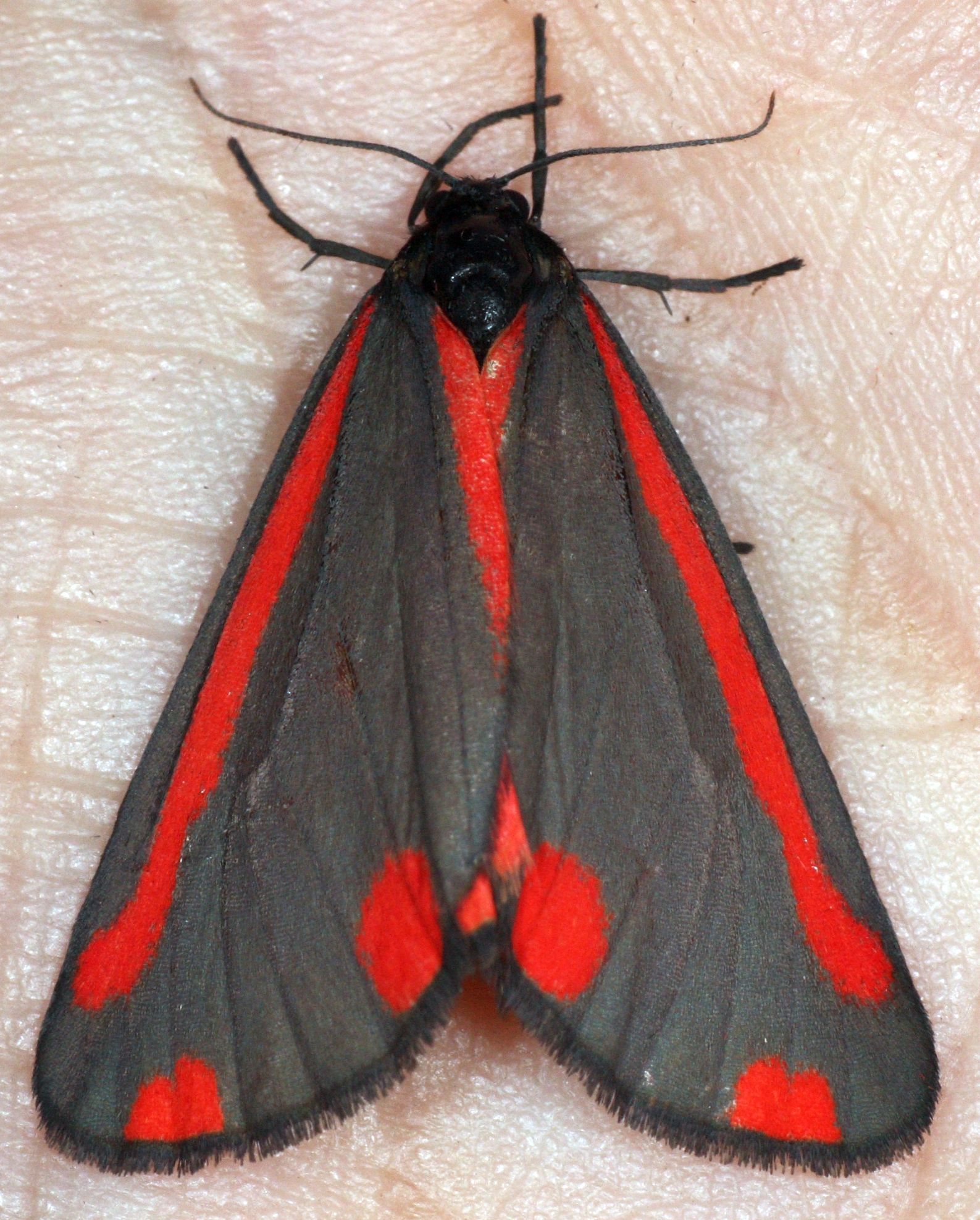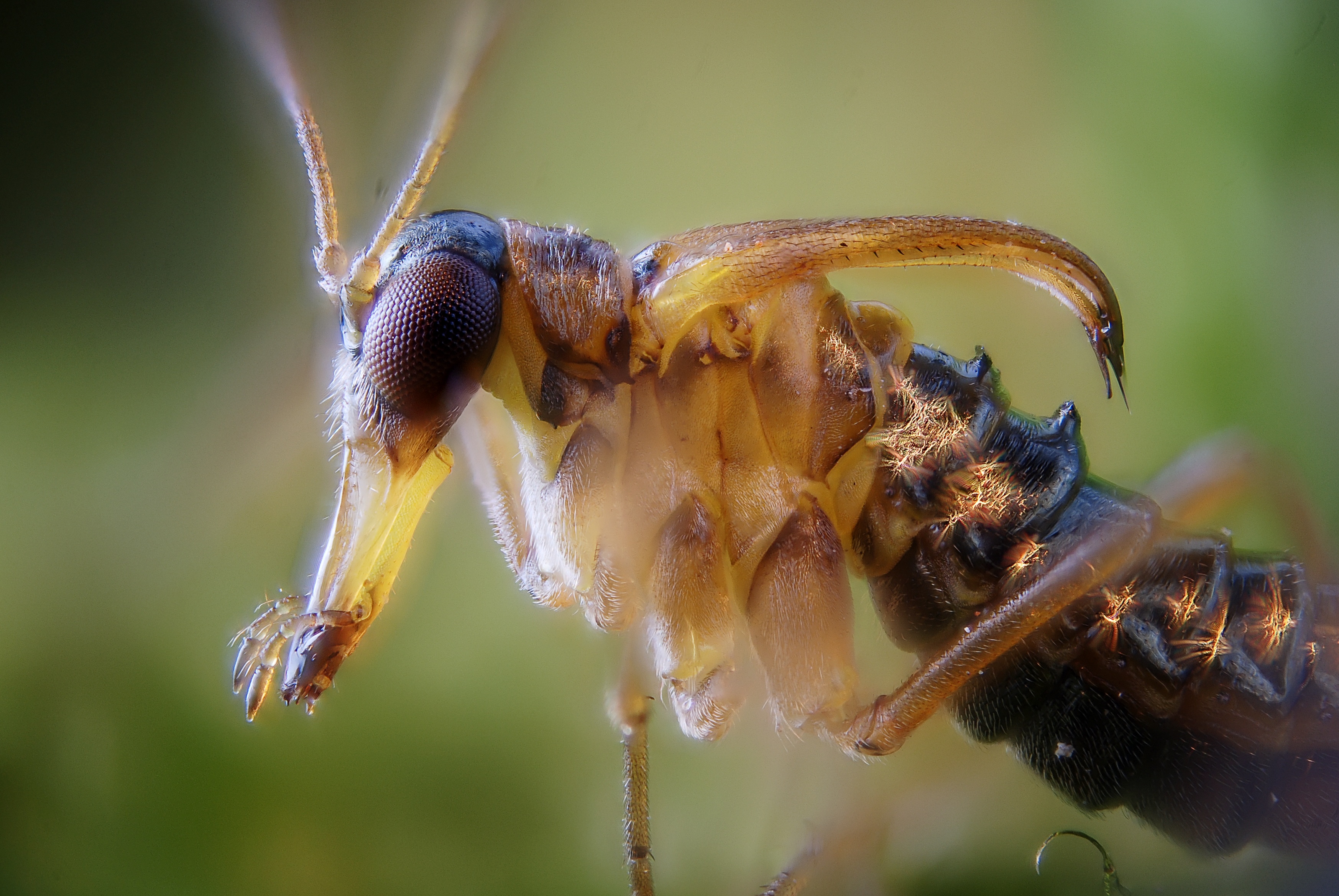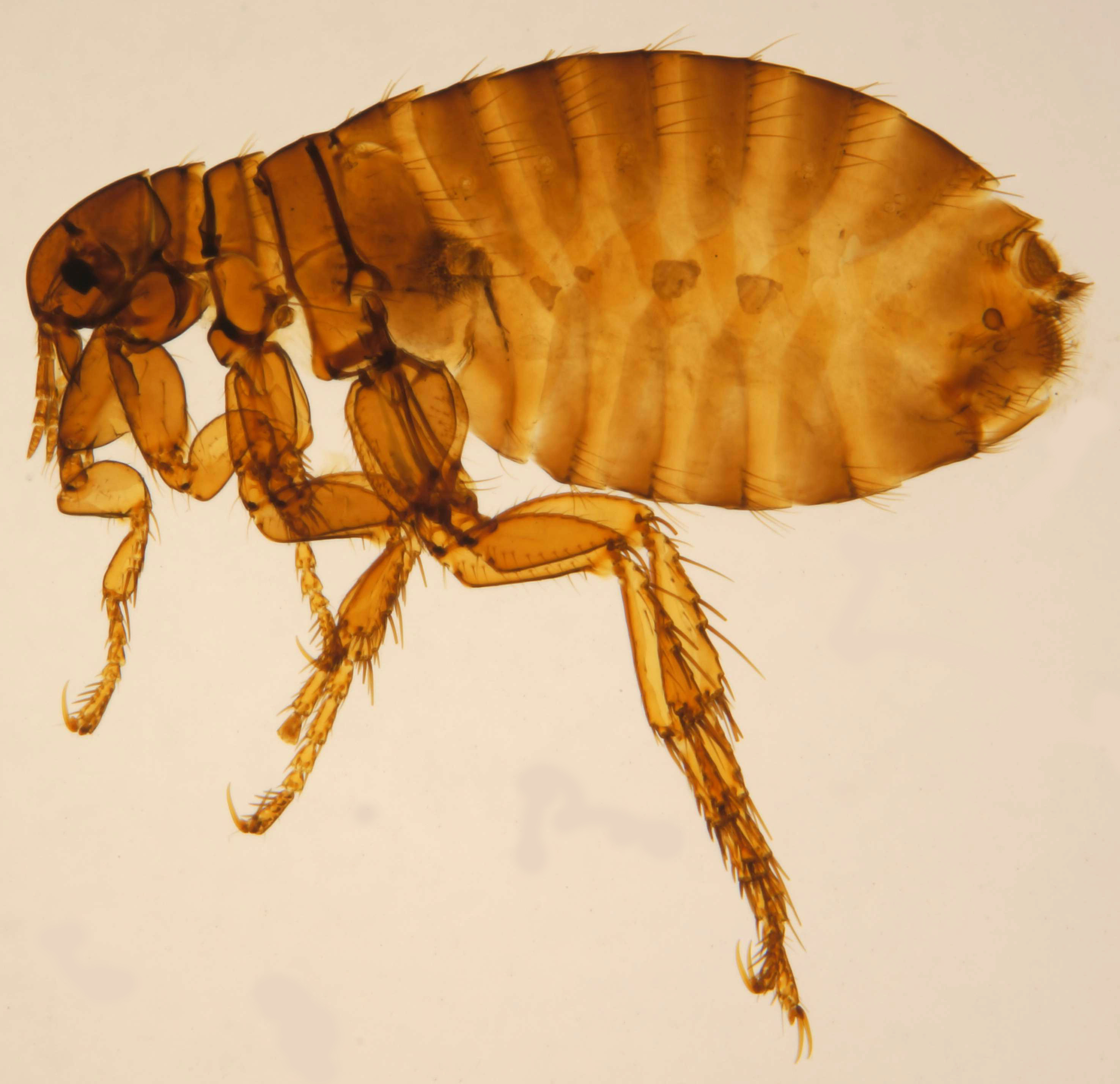|
Panorpida
Panorpida or Mecopterida is a proposed superorder of Endopterygota. The conjectured monophyly of the Panorpida is historically based on morphological evidence, namely the reduction or loss of the ovipositor and several internal characteristics, including a muscle connecting a pleuron and the first axillary sclerite at the base of the wing, various features of the larval maxilla and labium, and basal fusion of CuP and A1 veins in the hind wings. The monophyly of the Panorpida is supported by recent molecular data. Antliophora The Panorpid clade Antliophora contains one of the major phylogenetic puzzles among the Insecta. It is unclear as of 2020 whether the Mecoptera (scorpionflies and allies) form a single clade, or whether the Siphonaptera (fleas) are inside that clade, so that the traditional "Mecoptera" is paraphyletic. However the earlier suggestion that the Siphonaptera are sister to the Boreidae (snow scorpionflies) is not supported; instead, there is the possibility th ... [...More Info...] [...Related Items...] OR: [Wikipedia] [Google] [Baidu] |
Scorpionfly (white Background)
Mecoptera (from the Greek: ''mecos'' = "long", ''ptera'' = "wings") is an order of insects in the superorder Endopterygota with about six hundred species in nine families worldwide. Mecopterans are sometimes called scorpionflies after their largest family, Panorpidae, in which the males have enlarged genitals raised over the body that look similar to the stingers of scorpions, and long beaklike rostra. The Bittacidae, or hangingflies, are another prominent family and are known for their elaborate mating rituals, in which females choose mates based on the quality of gift prey offered to them by the males. A smaller group is the snow scorpionflies, family Boreidae, adults of which are sometimes seen walking on snowfields. In contrast, the majority of species in the order inhabit moist environments in tropical locations. The Mecoptera are closely related to the Siphonaptera (fleas), and a little more distantly to the Diptera (true flies). They are somewhat fly-like in appearanc ... [...More Info...] [...Related Items...] OR: [Wikipedia] [Google] [Baidu] |
Mecoptera
Mecoptera (from the Greek: ''mecos'' = "long", ''ptera'' = "wings") is an order of insects in the superorder Endopterygota with about six hundred species in nine families worldwide. Mecopterans are sometimes called scorpionflies after their largest family, Panorpidae, in which the males have enlarged genitals raised over the body that look similar to the stingers of scorpions, and long beaklike rostra. The Bittacidae, or hangingflies, are another prominent family and are known for their elaborate mating rituals, in which females choose mates based on the quality of gift prey offered to them by the males. A smaller group is the snow scorpionflies, family Boreidae, adults of which are sometimes seen walking on snowfields. In contrast, the majority of species in the order inhabit moist environments in tropical locations. The Mecoptera are closely related to the Siphonaptera (fleas), and a little more distantly to the Diptera (true flies). They are somewhat fly-like in appearance ... [...More Info...] [...Related Items...] OR: [Wikipedia] [Google] [Baidu] |
Panorpida
Panorpida or Mecopterida is a proposed superorder of Endopterygota. The conjectured monophyly of the Panorpida is historically based on morphological evidence, namely the reduction or loss of the ovipositor and several internal characteristics, including a muscle connecting a pleuron and the first axillary sclerite at the base of the wing, various features of the larval maxilla and labium, and basal fusion of CuP and A1 veins in the hind wings. The monophyly of the Panorpida is supported by recent molecular data. Antliophora The Panorpid clade Antliophora contains one of the major phylogenetic puzzles among the Insecta. It is unclear as of 2020 whether the Mecoptera (scorpionflies and allies) form a single clade, or whether the Siphonaptera (fleas) are inside that clade, so that the traditional "Mecoptera" is paraphyletic. However the earlier suggestion that the Siphonaptera are sister to the Boreidae (snow scorpionflies) is not supported; instead, there is the possibility th ... [...More Info...] [...Related Items...] OR: [Wikipedia] [Google] [Baidu] |
Antliophora
Panorpida or Mecopterida is a proposed superorder of Endopterygota. The conjectured monophyly of the Panorpida is historically based on morphological evidence, namely the reduction or loss of the ovipositor and several internal characteristics, including a muscle connecting a pleuron and the first axillary sclerite at the base of the wing, various features of the larval maxilla and labium, and basal fusion of CuP and A1 veins in the hind wings. The monophyly of the Panorpida is supported by recent molecular data. Antliophora The Panorpid clade Antliophora contains one of the major phylogenetic puzzles among the Insecta. It is unclear as of 2020 whether the Mecoptera (scorpionflies and allies) form a single clade, or whether the Siphonaptera (fleas) are inside that clade, so that the traditional "Mecoptera" is paraphyletic. However the earlier suggestion that the Siphonaptera are sister to the Boreidae (snow scorpionflies) is not supported; instead, there is the possibilit ... [...More Info...] [...Related Items...] OR: [Wikipedia] [Google] [Baidu] |
Endopterygota
Endopterygota (from Ancient Greek ''endon'' 'inner' + ''pterón'' 'wing' + New Latin ''-ota'' 'having'), also known as Holometabola, is a superorder of insects within the infraclass Neoptera that go through distinctive larval, pupal, and adult stages. They undergo a radical metamorphosis, with the larval and adult stages differing considerably in their structure and behaviour. This is called holometabolism, or complete metamorphism. Evolution The Endopterygota constitute the most diverse insect superorder, with over 1 million living species divided between 11 orders, containing insects such as butterflies, flies, fleas, bees, ants, and beetles. The earliest endopterygote fossils date from the Carboniferous. The Endopterygota are sometimes divided into three assemblages: Neuropterida (Neuroptera, Megaloptera, Raphidioptera, Strepsiptera and Coleoptera), Hymenopteroida (Hymenoptera), and Panorpida (Siphonaptera, Diptera, Trichoptera, Lepidoptera and Mecoptera) ... [...More Info...] [...Related Items...] OR: [Wikipedia] [Google] [Baidu] |
Nannochoristidae
Nannochoristidae is a family of scorpionflies with many unusual traits. It is a tiny, relict family with a single extant genus, '' Nannochorista'', with eight species occurring in New Zealand, southeastern Australia, Tasmania, Argentina and Chile. Due to the groups distinctiveness from other scorpionflies, it is sometimes placed in its own order, the Nannomecoptera. Some studies have placed them as the closest living relatives of fleas. Most mecopteran larvae are eruciform, or shaped like caterpillars. Nannochoristid larvae, however, are elateriform, and have elongated and slender bodies. The larvae are aquatic, which is unique among mecopterans. The larvae are predatory, hunting on the beds of shallow streams, primarily on the larvae of aquatic Diptera like chironomids. Fossils indicate that Nannochoristidae formerly had a wider distribution, being present in the Northern Hemisphere during the Jurassic and Early Cretaceous. Some research suggests the nannochoristids are the ... [...More Info...] [...Related Items...] OR: [Wikipedia] [Google] [Baidu] |
Boreus Hiemalis2 Detail
''Boreus'' is the most diverse of three genera of insects in the family Boreidae. They are commonly known as winter scorpionflies due to their close relation to the true scorpionflies and preference for cold habitats. Description and distribution Species of ''Boreus'' are dark in color, 3 to 5 mm long, and have reduced, non-functional wings. In males, the wings resemble straps, while in females they are short stubs. Females also have a pointed ovipositor. Both sexes have an elongated head, or rostrum. Larvae are grublike, mostly hairless and lacking prolegs. They have a holarctic distribution and are found in boreal and high altitude habitats. Biology ''Boreus'' species are highly adapted to cold environments and often found on the surface of snow. Although they cannot fly, they have the ability to hop or jump. All species are known to feed on mosses, both as adults and larvae. Males use their hardened wing straps to grasp the female and lift her above their back dur ... [...More Info...] [...Related Items...] OR: [Wikipedia] [Google] [Baidu] |
Hymenoptera
Hymenoptera is a large order of insects, comprising the sawflies, wasps, bees, and ants. Over 150,000 living species of Hymenoptera have been described, in addition to over 2,000 extinct ones. Many of the species are parasitic. Females typically have a special ovipositor for inserting eggs into hosts or places that are otherwise inaccessible. This ovipositor is often modified into a stinger. The young develop through holometabolism (complete metamorphosis)—that is, they have a wormlike larval stage and an inactive pupal stage before they mature. Etymology The name Hymenoptera refers to the wings of the insects, but the original derivation is ambiguous. All references agree that the derivation involves the Ancient Greek πτερόν (''pteron'') for wing. The Ancient Greek ὑμήν (''hymen'') for membrane provides a plausible etymology for the term because species in this order have membranous wings. However, a key characteristic of this order is that the hindwings are ... [...More Info...] [...Related Items...] OR: [Wikipedia] [Google] [Baidu] |
Amphiesmenoptera
Amphiesmenoptera is an insect superorder, established by S. G. Kiriakoff, but often credited to Willi Hennig in his revision of insect taxonomy for two sister orders: Lepidoptera (butterflies and moths) and Trichoptera (caddisflies). In 2017, a third fossil order was added to the group, the Tarachoptera. Trichoptera and Lepidoptera share a number of derived characters (synapomorphies) which demonstrate their common descent: * Females, rather than males, are heterogametic (i.e. their sex chromosomes differ). * Dense setae are present in the wings (modified into scales in Lepidoptera). * There is a particular venation pattern on the forewings (the double-looped anal veins). * Larvae have mouth structures and glands to make and manipulate silk. Thus these two extant orders are sisters, with Tarachoptera basal to both groups. Amphiesmenoptera probably evolved in the Jurassic. Lepidoptera differ from the Trichoptera in several features, including wing venation, form of the scales on ... [...More Info...] [...Related Items...] OR: [Wikipedia] [Google] [Baidu] |
Pulex Irritans Female ZSM
''Pulex'' is a genus of fleas. It comprises seven species. One is the human flea (''P. irritans''), and five of the others are confined to the Nearctic and Neotropical realms. Species ''Encyclopedia of Life'' lists seven species: *''Pulex alvarezi'' Barrera, 1955 *''Pulex echidnophagoides'' (Wagner, 1933) *''Pulex irritans'' Linnaeus, 1758 *''Pulex larimerius'' Lewis et Grimaldi, 1997 *''Pulex porcinus'' Jordan et Rothschild, 1923 *''Pulex simulans'' Baker, 1895 *''Pulex sinoculus ''Pulex'' is a genus of fleas. It comprises seven species. One is the human flea (''P. irritans''), and five of the others are confined to the Nearctic and Neotropical realms. Species ''Encyclopedia of Life'' lists seven species: *''Pulex alvar ...'' Traub, 1950 References Siphonaptera genera Pulicidae Taxa named by Carl Linnaeus {{Flea-stub ... [...More Info...] [...Related Items...] OR: [Wikipedia] [Google] [Baidu] |
Species
In biology, a species is the basic unit of classification and a taxonomic rank of an organism, as well as a unit of biodiversity. A species is often defined as the largest group of organisms in which any two individuals of the appropriate sexes or mating types can produce fertile offspring, typically by sexual reproduction. Other ways of defining species include their karyotype, DNA sequence, morphology, behaviour or ecological niche. In addition, paleontologists use the concept of the chronospecies since fossil reproduction cannot be examined. The most recent rigorous estimate for the total number of species of eukaryotes is between 8 and 8.7 million. However, only about 14% of these had been described by 2011. All species (except viruses) are given a two-part name, a "binomial". The first part of a binomial is the genus to which the species belongs. The second part is called the specific name or the specific epithet (in botanical nomenclature, also sometimes i ... [...More Info...] [...Related Items...] OR: [Wikipedia] [Google] [Baidu] |
Pistillifera
Pistillifera is a suborder of endopterygote insects within the Antliophora that contains the scorpionflies Mecoptera (from the Greek language, Greek: ''mecos'' = "long", ''ptera'' = "wings") is an Order (biology), order of insects in the superorder Endopterygota with about six hundred species in nine Family (biology), families worldwide. Mecopterans ... and hangingflies. It was described by R. Willmann in 1987. References {{Taxonbar, from=Q108687888 Antliophora Insect suborders ... [...More Info...] [...Related Items...] OR: [Wikipedia] [Google] [Baidu] |









